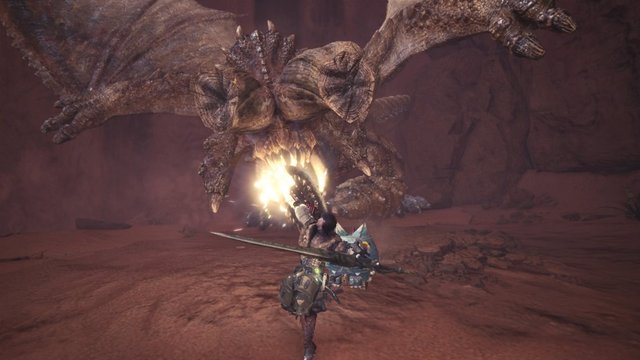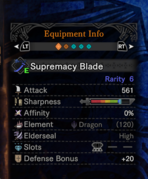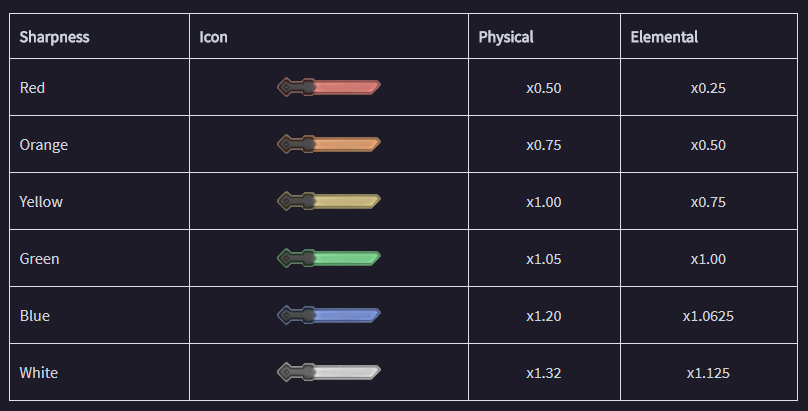Dealing The Most Damage in Monster Hunter: World
The core gameplay of Monster Hunter, regardless of what iteration of the series you're playing, is the act of hunting powerful monsters. You go in all geared up and decked out, and go ham.

To simplify any guide written for Monster Hunter's complex combat, simply refer to the two tenets of skilled MonHun gameplay:
- hit things until they die
- don't get hit
And that, ladies and gentlemen, is all there is to it.
Of course, it's not quite that simple. Monster Hunter: World is the latest in a series of modern video games built around challenging and satisfying gameplay - it's not about creating artificial challenge through inflated health values and low player damage, or through paywalls and microtransactions. In Monster Hunter, the game has a simple and fair premise, gives you the tools to succeed, and forces you to rely entirely on your skill as a player to complete the objective, and improve in the long-run.
Half the fun in Monster Hunter is beating a monster that was giving you hell - and it is often those moments that turn a frustrated, alienated player into a new life-long fan.
But where many find fun in going toe-to-toe against monsters again and again, some of us are compulsive nerds who need to pick apart a game's every mechanic until we turn on our consoles and see the inner workings of the game with our third eye. If you are a fellow minmaxer (someone who wants maximum performance gear-wise), then strap in, because this is the guide you were looking for. Today, we'll discuss how damage works in Monster Hunter, and how you can calculate and compare builds for maximum DPS.
What Is Attack Power and True Raw?
When you check your equipment info in-game, you will see that you've got an attack power indicated on your general hunter info screen, next to your affinity, health, stamina, defense and elemental resistances. This is your displayed raw. Raw indicates "raw damage", disregarding affinity or elemental/status damage, which is calculated after the raw attack power of your weapon.

However, your displayed attack power - in your equipment screen - already takes into account several different things. We need to dig deeper to the basics of Monster Hunter damage values - and for that, we need to understand what true raw is.
Every weapon in the game has a true raw value, and in the end-game of Monster Hunter World this typically ranges from 180 to 230. G-rank weapons go even higher with their true raw, but are absent in this game. When you go to craft a hammer, the number you see in the Attack Value slot is the weapon's true raw modified by its weapon modifier. These bloated attack numbers honestly just complicate things, but they do a good job of indicating the overall speed of a weapon - weapons with bigger numbers tend to have slower swing speeds, while weapons that hit very quickly and very often have smaller Attack Values. That is a consequence of their respective weapon modifiers.
When calculating between different options of a single weapon type (choosing between hammer A and hammer B), you can basically leave weapon modifiers out of the equation. Instead, take the weapon's true raw and any raw modifiers.
Raw modifiers come in the form of armor skills, items, kitchen buffs and horn buffs. We'll take the Diablos Shatterer II as an example here. It is a hammer with 230 true raw and -25% affinity.
Armor Skills
If your armor skills include Attack Boost 6 and Agitator 5 (a common duo in hammer mixed sets), then you have a total additional raw of 38 (18 from Attack, 20 from Agitator) when a monster is enraged, which is common. This boosts your weapon's true raw to 268.
Other armor skills affect raw as well. Here are a few, not counting the two mentioned above:
| Armor Skill | Effect |
|---|---|
| Peak Performance | 3 Levels. Adds 20 true raw to your weapon if your health is full. |
| Heroics | 5 Levels. Activates when your health is low, takes your weapon's true raw and adds a total 30% - a huge boost. |
| Fortify | 1 Level. Adds 10% after two faints. |
| Non-Elemental Boost | 1 Level. Adds another 10% for weapons without active status/element (includes unawakened weapons). |
| Resentment | 5 Levels. Adds up to 25 true raw whenever you take damage and are still recovering with red HP. |
Food and Item Buffs
Given Attack 6 and Agitator 5, factor in the Attack Up kitchen skill (5/10/15 raw), and a few booster items, you can take the Diablos hammer and pump its raw up to a relatively consistent 310. Here are the item buffs that stack:
- Might Seed (lasts 3 minutes, adds 10 raw)
- Might Pill (lasts 20 seconds, adds 20 raw)
- Mega Demondrug (lasts until fainting, adds 7 raw)
- Demon Powder (lasts three minutes, adds 10 raw)
The Might Pill is highly situational due to its low duration, but allows you to get that raw up to 330 for a short time. However, raw alone is not the key to victory.
Affinity And Why It Matters
Affinity is basically a weapon's crit chance. However, critical hits are not as important in Monster Hunter as they may be in many other games. A crit in Monster Hunter takes your raw damage and multiplies it by 1.25. A negative crit (for negative affinity) deals x0.75 damage.

Credits to Kiranico
Because it's a percentage chance to get a crit (for example, 20% affinity represents a 20% chance to hit 25% harder), there is a formula for calculating crit and true raw to get to calculated raw. The formula is:
True Raw x (1 + 0.Affinity x (25/100)) = Calculated Raw
Critical Boost modifies crit damage, changing it to 1.30, 1.35, and 1.40 for each level. If your set uses Critical Boost, simply replace 25/100 with your critical hit damage (i.e. 40/100). If you're not using Critical Boost, you can further simplify this for easy usage:
True Raw x (1 + 0.Affinity x 0.25) = Calculated Raw
Negative raw works much the same way - simply amend your formula. For example, the Diablos Shatterer II without any armor skills, augmentations or buff items would have a calculated raw of:
230 x (1 - 0.25 x 0.25) = 215
But for our Diablos hammer build, assuming we're using our buffs and taking into consideration our armor, we're looking at 310 raw and 10% affinity (due to Agitator 5, and two Affinity augmentations adding 20% affinity):
310 x (1 + 0.10 x 0.25) = 317
Always round down. But what if we add Weakness Exploit into the mix? It's another very common armor skill for damage, and assuming we're hitting heads here (which we should be doing), we effectively have 50 extra affinity. Thus:
310 x (1 + 0.60 x 0.25) = 356
This isn't how much damage we're doing on a crit, rather, it's an approximation of how much damage we're doing in general/on average. You can take the formula and adapt it for yourself. Throw in Critical Eye for more affinity, or Critical Boost to change 1.25 to higher, better values.
But of course, we're not done. What do we do with this calculated raw? We determine the weapon's sharpness.
Sharpness Modifiers
Sharpness modifiers are the extra damage a weapon deals when in a certain level of sharpness. The modifiers are as follows:

Credits to Kiranico
Because of the jump from blue to white (1.2 to 1.32) it's easy to see why some weapons with decent raw but amazing white sharpness outperform weapons with high raw but low sharpness.Similarly, hitting yellow is such a steep drop (35%) that it must be avoided at all costs. Higher sharpness also prevents bouncing from some monster hides, making it doubly useful. Sharpness modifiers are typically thrown in before affinity, but the end result is the same. You can easily test this (always round down).
310 x (1 + 0.60 x 0.25) x 1.2 = 427
310 x 1.2 x (1 + 0.60 x 0.25) = 427
Our Diablos Shatterer II has blue sharpness. However, there are builds that allow you to sacrifice raw for massively improved sharpness. For example, by combining a Handicraft Charm III with the Kushala Alpha mail and Xeno'Jiiva gear, you can attain Handicraft 5 and the Razor Sharp effect from Xeno'Jiiva' set bonus, consistently giving you white sharpness at the cost of raw from Attack Boost and Agitator. Do your own calculations to see if the sharpness to raw tradeoff is worth it for you.
Weapon Modifiers and Motion Values
Once we have our calculated raw, including raw boosts, affinity, and sharpness. This is all you need when comparing options within weapon types. It's not possible to compare between weapons, because of the variables in performance and DPS, but using the formulas above you can decide which hammer to take with you, and which set to craft for it.
But what if you want to know how much damage you can deal in a single hit? It's time to take into consideration three crucial things: weapon modifiers, damage types, and motion values.
Weapon modifiers are the cause of bloated attack values, as mentioned previously. Aside from giving you a sense of how "big" the weapon is, they don't do much. An attack's actual power is determined by its motion value. The bigger the motion value, the more powerful the attack. Weapons like hammers have on average much higher motion values than weapons like dual blades, but they still have some attacks with far greater motion values than others. For example, the motion value for the last hit in the hammer's Big Bang combo has a much larger motion value than the rest of the combo.
When calculating the damage of a specific hit, rather than the weapon itself, the motion value is the first thing you take into consideration after raw, affinity and sharpness. It's a simple modifier - a motion value of 40 means 40% of your total calculated attack.
Hitzones
So we've got attack power and motion values down - what's next? Hitzones. Hitzones are where the monster actually comes into play - they determine the amount of damage you're actually landing, and subtracting off the monster's hidden HP value. Hitzones above 45 are considered weakzones - hitting these activates Weakness Exploit, giving you an additional 50% affinity. Much like motion values, hitzones are modifiers - a hitzone of 50 means 50% of your attack is landing.
This is where damage types also come into play. Hitzones change depending on the damage type you use to hit that hitzone. Rathalos' head has a cutting hitzone of 50, but an impact hitzone of 70. In other words, he hates hammers. If you're gunning, his head also has a hitzone of 50.
So say you hit a crit with 310 raw and blue sharpness hammer, on a 91 MV move (final hit of the stationary power charge combo) on Rathalos' head (70 hitzone for impact damage). That's:
310 x 1.2 x 0.91 x 0.70 = 236
Elemental & Status Weapons
I'm predominantly a hammer and charge blade user, so when it comes to elemental weaponry, I basically don't care much at all given the usefulness of the Non-Elemental Boost skill. But other people do care - so it's important to educate them on how to calc for elemental damage.
Much like how different damage types get different hitzones, elemental damage is also hitzone-dependent. For an elemental blademaster weapon, you'll want to calculate your elemental damage and raw damage separately. Keep in mind everything I've written about raw damage, and now create a separate calc for the elemental damage to add the two. Only faster weapons are viable for both elemental and status application, as these are per hit, and motion values do not matter.
First, refer to the sharpness modifiers above. Then, take your weapon's elemental damage number, multiply it by the sharpness modifier, and check the monster's elemental weakzone.
Rathalos' head has a dragon weakness of 25. We'll take the Enduring Schism as an example, with 270 Dragon element and 140 true raw. We know how to calc for raw. But what about elemental?
270 Dragon actually translates to 27. Elemental attacks land 33% of the time. Assuming you do not crit, that's 27 damage dealt to a hitzone of 25 - so a quarter of that damage applies. Rounded down, taking blue sharpness into account, that is 7 extra damage for every third hit on average. Because of this, it is not strictly a good idea to focus entirely on elemental damage when picking dual blades. Choose something middle-of-the-road, like Nergigante's dual blades, or Xeno'Jiivas.
Status damage works differently. Status damage again only deals 10% of the displayed status stat, and this still happens only 33% of the time, but hitzones do not matter. A status weapon will deal status no matter where it hits, and this status builds up until a monster's initial threshold is reached. Then, it falls asleep/gets paralyzed/is poisoned.
When the status wears off, the threshold is increased slightly, until it reaches a maximum. This makes it harder and harder to achieve the next instance of poison/sleep/paralysis.
Fixed Damage
Some weapons deal additional fixed damage. This is damage dealt regardless of hitzones, affinity or sharpness. The two most note-worthy weapons with fixed damage are the charge blade and the gunlance. Both weapons have explosive phials that can be made more powerful through the Artillery skill, which increases shelling/impact phial damage by 30% at Level 3. Like elemental damage, this can simply be added onto the attack itself.
For example, an SAED has a massive motion value in the axe strike, alongside 1-6 phial explosions based on the weapon's raw, Artillery, and how many phials are loaded into the blade (Capacity Boost skill adds an additional phial). The same goes for the gunlance's full-burst, which unloads the entire magazine. Additionally, a charge blade's phial damage is tied to the weapon's raw, rather than being truly "fixed"
Do You Like Big Numbers?
This is a lot of technical information, but it helps when comparing weapons and testing sets. Maybe you'd like to swap out your Tenderizer jewel for that Attack jewel you just got. But is the jump from 18 raw and 5% affinity to 21 raw and 5% affinity worth the drop from 50% affinity to 30% affinity? Is it better to prioritize white sharpness on a heavy-hitting Diablos weapon, or stack raw? Give it a go and see what you come up with.
Your post is always helpful and its really fun to read it <3
@luckypower Thank you so much!